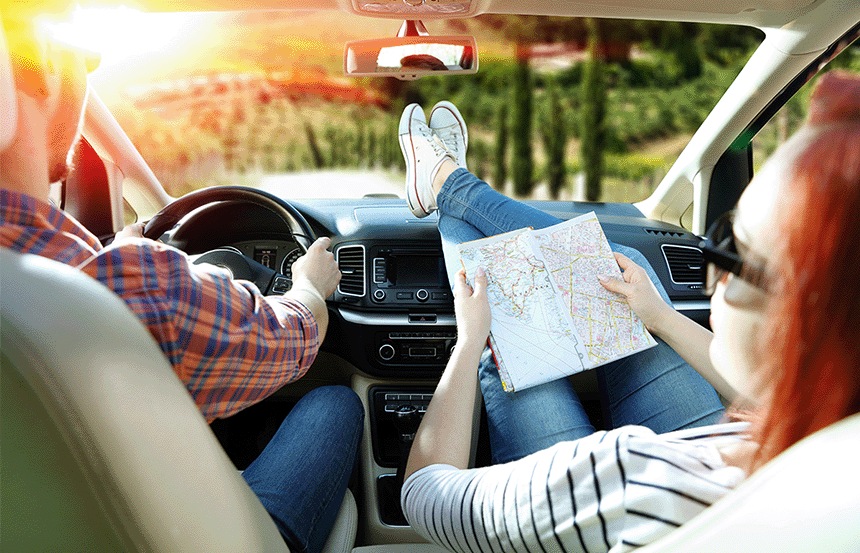Road trips always thrill us in and out, especially when it is with our friends. The adventure and the gossip sessions with many snacks are all you need for this upcoming season. A perfect road trip is incomplete without any heat-up fight between 2 friends or a car puncture, and there is always one who gets the headache, especially when heading towards the mountains. I hope you can feel the zeal where I am heading toward. Yes, you heard it right. These are essential packing tips for a road trip and a smooth journey.
In this blog, we'll provide not too much information that will block your mind, but yes, we will share the best tips that are useful for you to enjoy the memorial banger with friends and family.
Car Charging Or Batteries
Car charging or battery management is essential for uninterrupted travel during a road trip. Planning charging stops along the route ensures sufficient power supply. Utilizing public charging stations or booking accommodations with charging facilities can alleviate range anxiety. Fast charging options reduce waiting times. Efficient battery usage can extend driving range by optimizing climate control and minimizing power-draining features. Preparedness and awareness of charging infrastructure contribute to a smooth and enjoyable road trip experience.
Pillow
A perfect pillow provides optimal comfort and support for a restful night's sleep. It should align the head, neck, and spine, promoting proper posture. The ideal pillow's firmness and loft level depend on personal preferences and sleep positions. Materials like memory foam, down, or latex offer different levels of contouring and responsiveness. A breathable and hypoallergenic cover adds to overall comfort and hygiene. Ultimately, a perfect pillow helps you wake up refreshed and rejuvenated each morning.
Reusable Water Bottles
A reusable water bottle is an eco-friendly alternative to single-use plastic bottles. It is designed to be used multiple times, reducing waste and environmental impact. Reusable water bottles are typically stainless steel, glass, or BPA-free plastic. They are durable, leak-proof, and easy to clean. Using a reusable water bottle helps conserve resources, reduces plastic pollution, and promotes sustainable practices. It's a simple yet impactful way to stay hydrated while being mindful of the planet.
Flashlights
Flashlights are portable, hand-held devices that provide a concentrated beam of light. They typically consist of a light source, such as an LED or an incandescent bulb, housed in a durable and compact casing. Flashlights are powered by batteries and are commonly used for illumination in various situations. They are essential for emergencies, outdoor activities, camping, and navigating dark areas. Flashlights come in different sizes, lumens, and features, such as adjustable focus, multiple light modes, and waterproof capabilities.
A Bag Full Of Snacks
A bag of snacks is a convenient and satisfying way to keep hunger at bay while on the go. It can include various items such as granola bars, nuts, dried fruits, crackers, popcorn, and energy bars. Snack bags can be customized to suit individual preferences and dietary needs. They provide quick and easily accessible sustenance during road trips, hikes, flights, or any other situation where a portable snack option is desirable. Packing a bag of snacks ensures you have tasty treats readily available whenever hunger strikes.
Emergency Equipment
Emergency equipment refers to a range of vital tools and supplies during unexpected or crisis situations. Some common examples include:
- Fire Extinguisher: Used to extinguish small fires and prevent them from spreading.
- Flashlight: Provides illumination during power outages or in dark environments.
- Emergency Blanket: Helps retain body heat and provides insulation in case of exposure to cold weather.
- Whistle: Used to attract attention and signal for help in emergency situations.
- Multi-Tool: A versatile tool that combines various functions like cutting, screwdriving, and opening.
- Emergency Radio: Enables access to important weather updates, news, and emergency broadcasts.
First Aid Box
A first aid kit is a savior box of medical supplies and equipment for the initial treatment of injuries and emergencies. It is essential to have a well-stocked first aid box in homes, workplaces, and vehicles. The contents of a first aid box may vary depending on the intended use and the level of training of the individuals who may administer first aid. However, some common items found in a basic first aid box include:
- Adhesive bandages (various sizes)
- Sterile gauze pads and adhesive tape
- Antiseptic wipes or solution
- Tweezers and scissors
- Disposable gloves
- CPR mask or face shield
- Disposable resuscitation bag (for CPR)
- Instant cold packs
- Pain relievers (e.g., acetaminophen or ibuprofen)
- Antihistamines (for allergic reactions)
- Antibiotic ointment
- Burn ointment or gel
- Eye wash solution
- Elastic bandages and splints
- First aid manual or instruction booklet
It is important to periodically check and replenish the contents of the first aid box to ensure that supplies are not expired or depleted. Additionally, it is recommended to have basic knowledge of first aid procedures or attend a training course to effectively utilize the supplies in a first aid box.
Weather Related Accessories
Weather-related accessories help individuals adapt and prepare for different weather conditions. Here are some examples:
- Umbrella: Protects from rain and provides shade on sunny days.
- Sunscreen: Shields the skin from harmful UV rays during sunny weather.
- Sunglasses: Protect the eyes from bright sunlight and glare.
- Hat or Cap: Provides shade and helps keep the head cool in sunny weather.
- Gloves: Keeps hands warm in cold weather.
- Scarf: Provides warmth and protects the neck from cold winds.
- Raincoat or Waterproof Jacket: Keeps the body dry during rainy weather.
- Boots or Waterproof Shoes: Provides protection and traction in wet or snowy conditions.
- Thermal Layers: Insulating clothing to stay warm in cold temperatures.
- Fans or Cooling Towels: Helps cool down in hot and humid weather.
- Windproof Umbrella: Designed to withstand strong winds.
- Ice Grippers or Crampons: Attachments for shoes for traction on icy surfaces.
- Heating Pads or Hand Warmers: Provides warmth in cold weather.
- Thermos or Insulated Water Bottle: Keeps beverages hot or cold depending on the weather.
- All-Weather Backpack or Bag: Durable and water-resistant for protecting belongings.
These weather-related accessories can help individuals stay comfortable, protected, and prepared for various weather conditions. It's important to consider the local climate and weather patterns when selecting the appropriate accessories
Cloth Related To weather
Choosing appropriate clothing according to weather conditions is crucial for comfort and protection. Here are some general guidelines for different weather conditions:
Hot and Sunny Weather:
- Wear lightweight and breathable fabrics such as cotton or linen.
- Opt for loose-fitting clothing that allows air circulation.
- Choose light-colored clothing to reflect sunlight.
- Wear a wide-brimmed hat and sunglasses for sun protection.
- Use sunscreen to protect exposed skin.
Cold and Winter Weather:
- Layer clothing for insulation. Start with a moisture-wicking base layer, add a warm middle layer, and top it off with a windproof and waterproof outer layer.
- Choose fabrics like wool or fleece for added warmth.
- Wear a hat, gloves, and scarf to protect extremities.
- Insulate feet with warm socks and waterproof boots.
- Consider thermal underwear for extra insulation.
Rainy Weather:
- Wear a waterproof or water-resistant jacket with a hood.
- Opt for waterproof or water-resistant pants or skirts.
- Choose footwear that can withstand wet conditions, such as rain boots.
- Carry an umbrella or a compact raincoat for added protection.
Windy Weather:
- Wear multiple layers to trap warm air and protect against wind chill.
- Use windproof outer layers to block the wind.
- Choose a hat that covers the ears to protect them from windburn.
- Wear gloves or mittens to protect your hands from cold winds.
It is important to note that these are general guidelines and that specific weather conditions may require additional or specialized clothing. It is always advisable to check the weather forecast and dress accordingly to ensure comfort and safety.










